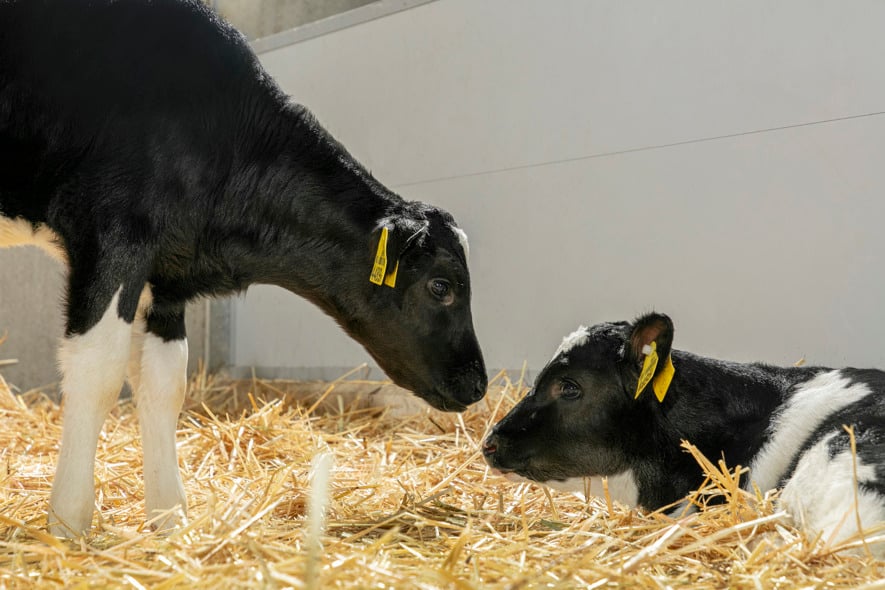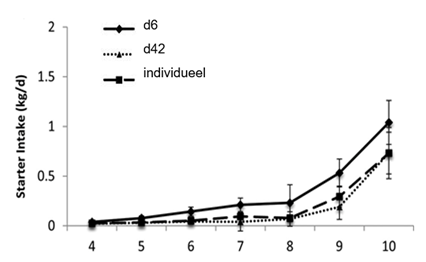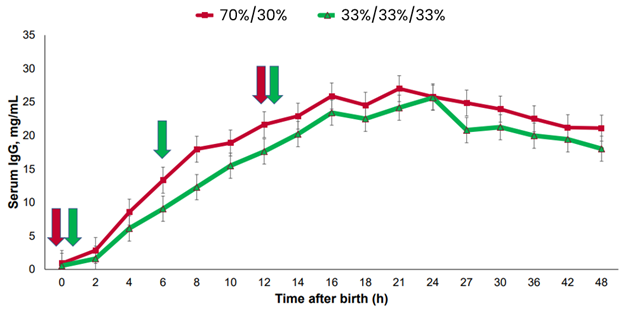Pair housing of calves
- Ruminants
Traditionally, calves are separated from the cow immediately after birth as soon as possible to avoid contamination with germs excreted by the cow or from the environment. The calf is then given colostrum and placed in a single-stall pen. To also prevent mutual contamination, the single-stall pens are usually at least 1-1.5 meters apart.

However, in recent years, more and more studies have been conducted on the effects of pair housing compared to individual housing, with regards to feed intake, daily growth, disease incidence and social development. The studies by Van Os et al, 2022 and Costa et al, 2015 show that calves housed together, both in winter and summer, spend more than 80% of their time together. This results in more social behaviour (both towards each other and the farmer), more play, increased feed intake of pellets and, as a result, better growth (see graph 1, tables 1 & 2).
It is extremely important for our industry that consumers continue to appreciate the efficient practices of our farmers in terms of animal health, performance and welfare (see figure 1 in the study).

Figure 1: Results of a Minnesota study that surveyed 1,300 people on the social acceptance of different forms of calf housing (Perttu et al., 2020).

Graph 1: calves housed in pairs as early as day 6 clearly have higher feed intake compared to calves housed individually or not housed together until day 42 (Costa et al., 2015).

Table 1: Calves housed in pairs grew 136 g per day more rapidly, weighing 7.1 kg more at 50 days of age (Knauer et al., 2021).

Table 2: An overview of studies showing more growth with pair housing compared to individual housing (Jensen et al., 2015|Costa et al., 2015| Knauer et al., 2021| Alejos de la Fuente et al., 2021).
What requirements do you need to meet if you want to implement pair housing?
-
Prevent infectious diseases
- First take measures to prevent contagious diseases on your farm: work hygienically, respect the walking lines from young to old and, if necessary, vaccinate both cows and calves. This prevents transmission between different age groups and does not exacerbate existing problems when you apply pair housing. Once calves are in pairs, it is very important to detect and treat diseases or symptoms such as diarrhea or respiratory problems early.
-
Optimise your colostrum management
- Aim for 4 litres of colostrum with at least 60 g IgG per litre or 240 g IgG per calf. This results in IgG levels of 20-25 g/L in the calves' blood. In the past, a standard of 10-15 g/L was used, but recent research shows that calves with higher IgG levels in the blood are less likely to get sick and grow better.
- The first donation is crucial! Studies show that antibody uptake is most efficient after the first dose. Therefore, make sure the first portion contains the most antibodies (see graph 2).
- If the cow's or heifer's colostrum contains too few antibodies (< 23-24% brix or < 55-60 g/L) or the volume is too low (< 4L), you can fortify it with Farm-O-San Colostrum. However, keep in mind that the efficiency of absorption of all commercial colostrum replacements is lower because of the treatment and heating of these antibodies (see graph 3).

Graph 2: For the red line, 70% of the antibodies are given in the first portion and the remaining 30% after 12 hours. For the green line, 33% of the antibodies are given each time at 0, 6 and 12 hours after birth.
Graph 3: IgG levels in the calf's serum: pure cow colostrum (green bars) and cow colostrum + colostrum replacer (blue bars). IgG levels are lower when using a colostrum substitute because of less efficient intake.
-
Feed calves enough milk to avoid cross-suckling
- A risk of housing calves in pairs is that after drinking their milk, they have the reflex to start suckling each other. This can lead to reduced growth due to stress, and at a young age, harmful bacteria can be transmitted by suckling, for example through the navel or teats. This can damage udder tissue and cause mastitis after the first calving. To prevent suckling together, we have created a modified LifeStart feeding schedule. By feeding more milk, calves benefit from a prolonged feeling of satiety and we also encourage faster growth.
